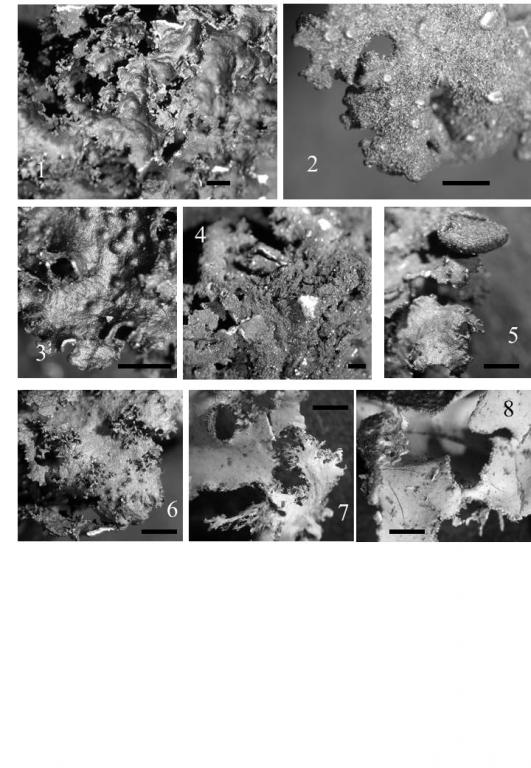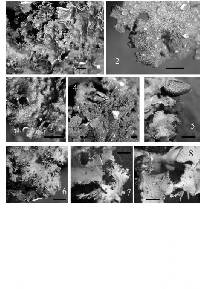
- Home
- Search
- Images
- Species Checklists
- US States: O-Z >
- US National Parks
- Central America
- South America
- US National Parks
- Southern Subpolar Region
|
|
|
|
Family: Peltigeraceae
|
Assessed as Endangered D, ver 3.1; date assessed: August 30, 2017
DOWNLOAD full IUCN Assessment as PDF Common name(s): English: n/a Identification Information: This is a very characteristic umbilicate stiped lichen that belongs to the genus Sticta but replaces the genus Umbilicaria, which is not known from all of New Guinea, on this mountain. Upper surface dark chocolate to blackish brown, glossy; often, but not on every lobe, with shallow reticulations and foveae. Lower surface black, mostly covered with a short felty layer of rhizinae, always with cyphellae. Rhizines50–150 μm long, simple or usually dichotomously branched, consisting of one row of isodiametrical, thick-walled cells, which are c. 10 μm diam., brown below, and tapering to c. 5 μm diam., hyaline for theupper 2–4 cells, which are markedly rounded and catenulate. Cyphellae ochraceous inside, 0·2–0·4 mm deep, 0·2–0·8 mm wide, margin slightly raised (thelotrematoid), glossy dark brown to black, 0·1 mm wide. Cortex identical on upper and lower surface, isidia and apothecium margin, paraplectenchymatous, cell walls thickened, darkbrown, 5–10 μm diam. Medulla ochraceous, unchanged in KOH. Photobiont nostocoid, cells in clusters,c. 4–7 μm diam., often compressed sideways. Lobes irregularly branched, concave or somewhat saddle-like contorted, flat, mostly 0·7–2·4 mm wide, 0·1–0·3 mm thick. Lobe margins much incised, always with pockets of isidia projecting upwards and sideways. Isidia simple to branched, knobbly to finger-like, often bent, glossy chocolate brown, 0·1–0·2 mm wide,up to 1·0 mm long, becoming detached leaving ochraceous scars. Soredia absent. Cilia absent. Apothecia occasionally present, sessile on a small stipe at the tips of lobes, 0·5–5·0 mm wide,0·3–1·7 mm high. Disc concave, shiny, chocolate brown. Apothecium margin rough, dull, dark brown, c.0·2–0·4 mm thick. Excipulum hyaline inside, brown in a small cortical zone, consisting of radiallyarranged, thickened cells 5–8 x 7–12 μm. Epihymenium fuscous brown, c. 50 μm high. Hymenium hyaline, not inspersed. Hypothecium ochraceous, c. 50 μm high. Paraphyses simple, hyaline, c. 2 μmwide, tip clavate, formed by 2–4 cells, tapering gradually up to4 μm wide, fuscous brown, with a truncate tip. Ascospores 4/ascus, fusiform with lower end tapering into a tail, hyaline, 3-septate, 40–55 x 7–10 μm. Pycnidia occasionally present, hemispherical,concolorous with thallus, 0·1–0·2 mm diam. Conidia not observed. Chemistry. No lichen substances detected, but with strong fishy smell. ASSESSMENT JUSTIFICATION [criteria: D] This species grows only in the summit area of a very high isolated mountain in the tropics. If the area would become subject to global warming, its natural niche (an oro-alpine situation) would vanish and the species would have no place to retreat to, and will be soon replaced by species that are adapted to milder climate in the unlikely case that it manages to adapt to a milder climate. Criterion A does not apply. Criterion B does not apply. Criterion C does not apply. Criterion D: Estimated population size acccording to the area occupied area is less than 250 individuals. So it can be assessed as Endangered under criterion D. Assessor/s: Thor, G. & Aptroot, A.; Reviewer/s: Scheidegger, C.; Contributor(s): Weerakoon, G. & Perez-Ortega, S, Dahlberg, A. Bibliography: Aptroot, A. (2008) Sticta alpinotropica, a new saxicolous lichen species from the alpine zone of Mt Wilhelm, Papua New Guinea. Lichenologist 40: 419-442. IUCN (2017) The IUCN Red List of Threatened Species. Version 2017-3. Available at: www.iucnredlist.org. (Accessed: 7 December 2017). Find out more about the IUCN Red List Categories and Criteria here. |












